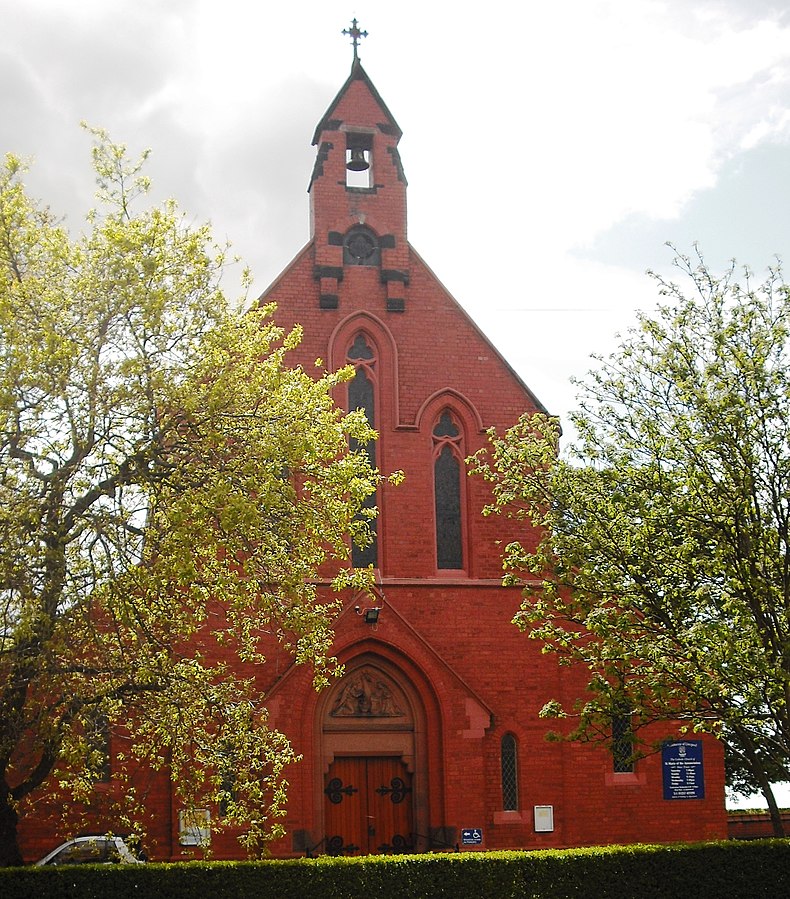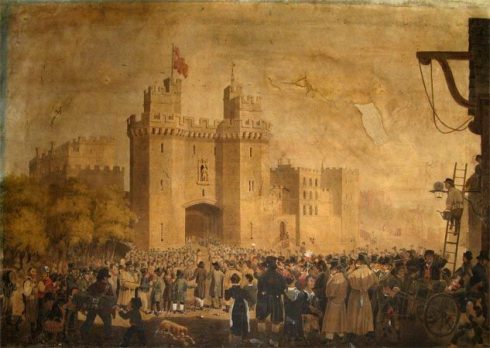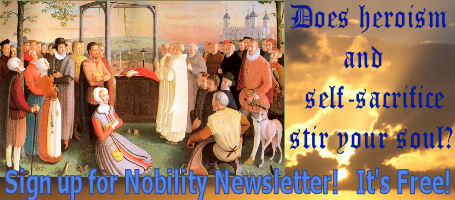Ven. Edward Bamber
(Alias Reading).
Priest and martyr, b. at the Moor, Poulton-le-Fylde, Lancashire; executed at Lancaster 7 August, 1646. Educated at the English College, Valladolid, he was ordained and sent to England. On landing at Dover, he knelt down to thank God, which act, observed by the Governor of the Castle, was the cause of his apprehension and banishment. He returned again, and was soon afterwards apprehended near Standish, Lancashire; he had probably been chaplain at Standish Hall. On his way to Lancaster Castle he was lodged at the Old-Green-Man Inn near Claughton-on-Brock, and thence managed to escape, his keepers being drunk. He was found wandering in the fields by one Mr. Singleton of Broughton Tower (who had been warned in a dream to help him), and was assisted and sheltered by him.

One of the oldest Catholic parishes in the Archdiocese – Church of St Marie of the Annunciation in Standish. Here they have a stained glass window depicting Ven. Edward being pushed off a ladder, which served as a gallows for his execution, by two soldiers. Photo by Martinevans123.
Arrested the third time, he was committed to Lancaster Castle, where he remained in close confinement for three years, once escaping, but recaptured. At his trial with two other priests, Whitaker and Woodcock, two apostates witnessed against him that he had administered the sacraments, and he was condemned to die. He suffered with great constancy, reconciling to the Church a felon executed with him, and encouraging his fellow-martyrs to die bravely. His conduct so enraged the persecutors that they urged the executioner to butcher him in a more than usually cruel and savage manner. An ode composed on his death is still extant.
Challoner, Memoirs (1750); Watson, Decacordon of ten Quodlibet Questions (1602); Gillow, Bibl. Dict. Eng. Cath. (London, 1885).
Bede Camm (Catholic Encyclopedia)
_____________
Ven. Thomas Whitaker
Born at Burnley, Lancashire, 1614; martyred at Lancaster, 7 August, 1646. Son of Thomas Whitaker, schoolmaster, and Helen, his wife, he was educated first at his father’s school. By the influence of the Towneley family he was then sent to Valladolid, where he studied for the priesthood. After ordination (1638) he returned to England, and for five years laboured in Lancashire. On one occasion he was arrested, but escaped while being conducted to Lancaster Castle. He was again seized at Place Hall in Goosenargh, and committed to Lancaster Castle, 7 August, 1643, being treated with unusual severity and undergoing solitary confinement for six weeks.
For three years he remained in prison, remarkable for his spirit of continual prayer and charity to his fellow-captives. Before his trial he made a month’s retreat in preparation for death. Though naturally timorous, and suffering much from the anticipation of his execution, he steadfastly declined all attempts made to induce him to conform to Anglicanism by the offer of his life. He suffered with Ven. Edward Bamber and Ven. John Woodcock, O.S.F., saying to the sheriff: “Use your pleasure with me, a reprieve or even a pardon upon your conditions I utterly refuse”.
CHALLONER, Memoirs of Missionary Priests (London, 741-2), following KNARESBOROUGH who had before him a contemporary account of the three martyrs.
Edwin Burton (Catholic Encyclopedia)
_____________
Ven. John Woodcock
English Franciscan martyr, b. at Leyland, Lancashire, 1603; suffered at Lancaster, 7 August, 1646. His parents, Thomas and Dorothy Woodcock, the latter a Catholic, were of the middle class. He was converted about 1622, and after studying at Saint-Omer for a year was admitted to the English College, Rome, 20 October, 1629. On 16 May, 1630, he joined the Capuchins in Paris, but soon afterwards transferred himself to the English Franciscans at Douai. He received the habit from the Venerable Henry Heath in 1631 and was professed by the Venerable Arthur Bell a year later. For some years he lived at Arras as chaplain to Mr. Sheldon. Late in 1643 he landed at Newcastle-on- Tyne, and was arrested on the first night he spent in Lancashire. After two years’ imprisonment in Lancaster Castle, he was condemned, on his own confession, for being a priest, together with two seculars, Edward Bamber and Thomas Whittaker, 6 August, 1646. When he was flung off the ladder the rope broke. Having been hanged a second time, he was cut down and diembowelled alive. The Franciscan nuns at Taunton possess an arm-bone of the martyr.
FOLEY, Records English Province S.J., VI (London, 1878-83), 322; CHALLONER, Missionary Priests, II (Edinburgh, 1877), no. 185; STANTON, Menology of England and Wales (London, 1887), 383-4; THADDEUS, Franciscans in England 1600-1859 (London and Leamington, 1898), 69, 70; POLLARD in Dict. Nat. Biog. s.v. Woodcock, Martin.
John B. Wainewright (Catholic Encyclopedia)











